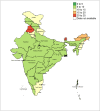The association of hypertension among married Indian couples: a nationally representative cross-sectional study
- PMID: 38710852
- PMCID: PMC11074266
- DOI: 10.1038/s41598-024-61169-1
The association of hypertension among married Indian couples: a nationally representative cross-sectional study
Abstract
Mounting evidence demonstrates that intimate partners sharing risk factors have similar propensities for chronic conditions such as hypertension. The objective was to study whether spousal hypertension was associated with one's own hypertension status independent of known risk factors, and stratified by socio-demographic subgroups (age, sex, wealth quintile, caste endogamy). Data were from heterosexual married couples (n = 50,023, women: 18-49 years, men: 21-54 years) who participated in the National Family Health Survey-V (2019-2021). Hypertension was defined as self-reported diagnosis of hypertension or average of three blood pressure measurements ≥ 140 systolic or 90 mmHg diastolic BP. Among married adults, the prevalence of hypertension among men (38.8 years [SD 8.3]) and women (33.9 years [SD 7.9]) were 29.1% [95% CI 28.5-29.8] and 20.6% [95% CI 20.0-21.1] respectively. The prevalence of hypertension among both partners was 8.4% [95% CI 8.0-8.8]. Women and men were more likely to have hypertension if their spouses had the condition (husband with hypertension: PR 1.37 [95% CI 1.30-1.44]; wife with hypertension: PR 1.32 [95% CI 1.26-1.38]), after adjusting for known risk factors. Spouse's hypertension status was consistently associated with own status across all socio-demographic subgroups examined. These findings present opportunities to consider married couples as a unit in efforts to diagnose and treat hypertension.
Keywords: Hypertension; India; Low- and middle-income country; Spousal concordance.
© 2024. The Author(s).
Conflict of interest statement
The authors declare no competing interests.
Figures


Update of
-
The association of hypertension among married Indian couples: a nationally representative cross-sectional study.Res Sq [Preprint]. 2024 Feb 2:rs.3.rs-3865512. doi: 10.21203/rs.3.rs-3865512/v1. Res Sq. 2024. Update in: Sci Rep. 2024 May 6;14(1):10411. doi: 10.1038/s41598-024-61169-1. PMID: 38352475 Free PMC article. Updated. Preprint.
References
-
- Geldsetzer P, Manne-Goehler J, Marcus ME, Ebert C, Zhumadilov Z, Wesseh CS, Tsabedze L, Supiyev A, Sturua L, Bahendeka SK, Sibai AM, Quesnel-Crooks S, Norov B, Mwangi KJ, Mwalim O, Wong-McClure R, Mayige MT, Martins JS, Lunet N, Labadarios D, Karki KB, Kagaruki GB, Jorgensen JMA, Hwalla NC, Houinato D, Houehanou C, Msaidié M, Guwatudde D, Gurung MS, Gathecha G, Dorobantu M, Damasceno A, Bovet P, Bicaba BW, Aryal KK, Andall-Brereton G, Agoudavi K, Stokes A, Davies JI, Bärnighausen T, Atun R, Vollmer S, Jaacks LM. The state of hypertension care in 44 low-income and middle-income countries: A cross-sectional study of nationally representative individual-level data from 1.1 million adults. Lancet. 2019;394(10199):652–662. doi: 10.1016/S0140-6736(19)30955-9. - DOI - PubMed
-
- Ministry of Health and Family Welfare, Government of India. Standard Treatment Guidelines for Hypertension: Screening, Diagnosis, Assessment and Management of Primary Hypertension in Adults in India. (Indian Council of Medical Research, 2016).
-
- Ministry of Health and Family Welfare. Operational Guidelines. Prevention, Screening and Control of Common Non-Communicable Diseases: Hypertension, Diabetes and Common Cancers (Oral, Breast, Cervix). (Government of India, 2018.
-
- Lee J, Wilkens J, Meijer E, Sekher TV, Bloom DE, Hu P. Hypertension awareness, treatment, and control and their association with healthcare access in the middle-aged and older Indian population: A nationwide cohort study. PLoS Med. 2022;19(1):e1003855. doi: 10.1371/journal.pmed.1003855. - DOI - PMC - PubMed
Publication types
MeSH terms
Grants and funding
LinkOut - more resources
Full Text Sources
Medical
Research Materials

